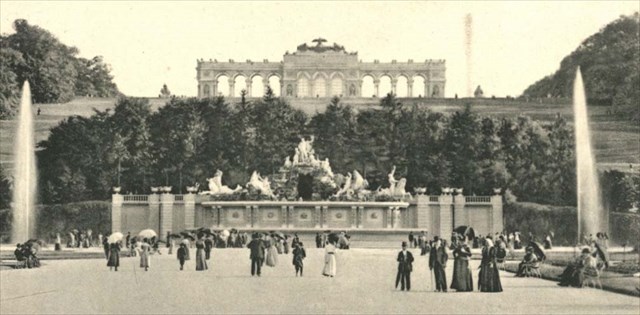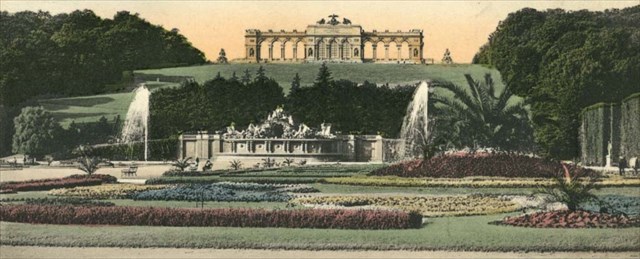


Neptune Fountain
Sited at the foot of the hill behind the palace and designed as the crowning element of the Great Parterre is the Neptune Fountain. It was conceived as part of the overall design of the gardens and park commissioned by Maria Theresa in the 1770s. Excavations for the pool began in 1776 and the fountain was completed four years later, just before the death of the empress. It was very probably designed by Johann Ferdinand Hetzendorf von Hohenberg, while the sculptural group of Sterzing marble was executed by Wilhelm Beyer.
A retaining wall curving back into the slope of the hill, its balustrade crowned with vases, forms the back wall of the vast basin. At the centre the wall is interrupted by a projecting, semi-oval plinth from which rises a rocky landscape peopled with the sea-god Neptune and his entourage. Retaining wall and plinth are articulated by blind panels, those on the plinth being decorated with masks, while the vertical elements separating them are embellished with garlands. At the centre of the figural group above a rocky grotto stands Neptune in a shell-shaped chariot, his trident in his hand. To his left is a nymph, while on his right kneels the sea-goddess Thetis, entreating Neptune to favour the voyage of her son, Achilles, who has set off to conquer Troy. Frolicking at the foot of the grotto are the Tritons, creatures who are half-man and half-fish, and belong to Neptune's entourage. They hold conch shell trumpets with which they can inspire fear in both man and beast, and are restraining the hippocampi or sea-horses who draw Neptune's chariot across the seas. Neptune driving across the seas in dominion over the watery element is a common motif in 16th to 18th-century art, being used as a symbol for monarchs controlling the destiny of their nations. The figural group was originally free-standing, but a screen of trees was planted behind it during the 19th century to provide a foil.
The park is open only during daylight. Please refer to the opening hours.
This Geocache is also listed at opencaching.de.



Neptunbrunnen
Am Fuße des Berghanges und als Abschluss des Großen Parterres erhebt sich der Neptunbrunnen, der zum Gesamtkonzept der Gartengestaltung durch Maria Theresia in den 1770er Jahren gehörte. 1776 wurde mit den Grabungen für das Bassin begonnen und nach einer vierjährigen Bauzeit konnte die Brunnenanlage noch vor dem Tod der Monarchin vollendet werden. Der Entwurf stammte mit großer Wahrscheinlichkeit von Johann Ferdinand Hetzendorf von Hohenberg, die Figurengruppe aus Sterzinger Marmor wurde von Wilhelm Beyer geschaffen.
Eine gegen den Berghang zurück schwingende Stützmauer, die mit einer vasenbesetzten Balustrade versehen ist, bildet die Rückwand des riesigen Brunnenbassins. In der Mitte wölbt sich ein halbovaler Sockel vor, auf dem sich eine Felslandschaft erhebt, die vom Meeresgott Neptun und seinem Gefolge bevölkert ist. Stützmauer und Sockel sind durch Blendtafeln gegliedert, am Sockel sind diese mit Masken versehen, die vertikalen Stützglieder mit Blumengirlanden geschmückt. Im Zentrum der Figurengruppe steht Neptun mit dem Dreizack in der Hand in einem Muschelwagen über einer Felsgrotte. Zu seiner Linken befindet sich eine Nymphe und zur Rechten kniet die Meeresgöttin Thetis. Sie bittet Neptun, die Seefahrt ihres Sohnes Achill zu begünstigen, der zur Eroberung Trojas aufgebrochen war. Am Fuß der Felsgrotte tummeln sich – halb Mensch und halb Fisch – die zu Neptuns Gefolge gehörenden Tritonen mit Muscheltrompeten in der Hand, die Mensch und Tier in Angst und Schrecken versetzen können. Sie lenken die so genannte Hippokampen, Meerespferde, mit denen Neptun die Meere befährt. Die in der Kunst des 16. bis 18. Jahrhunderts häufig dargestellte Meerfahrt des Neptun, das Element des Wassers beherrschend, stand als Gleichnis für den Fürsten, der die Kräfte des Landes zu lenken weiß. Die ursprünglich frei stehende Neptungruppe wurde im 19. Jahrhundert mit einer Baumkulisse hinterlegt.
Der Park ist nur bei Tageslicht geöffnet. Achte auf die Öffnungszeiten.
Der Cache ist auch auf Opencaching.de gelistet.
Quellen/Sources: www.schoenbrunn.at [EN], www.schoenbrunn.at [DE]
Bilder/Picture: Ansichtskarten Online der OeNB